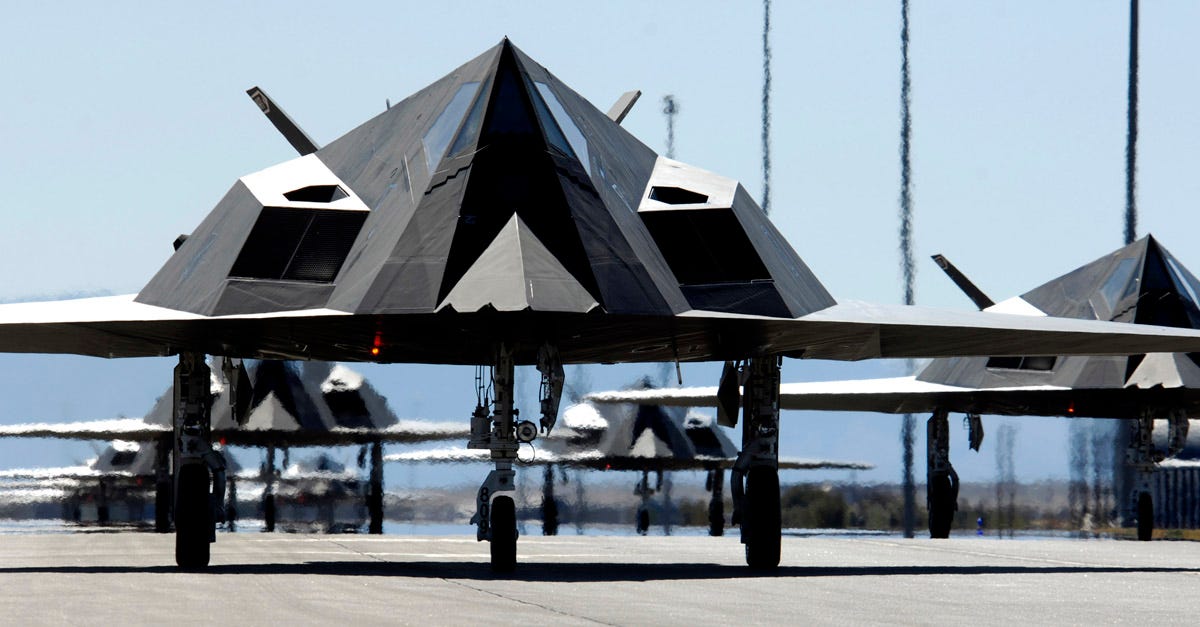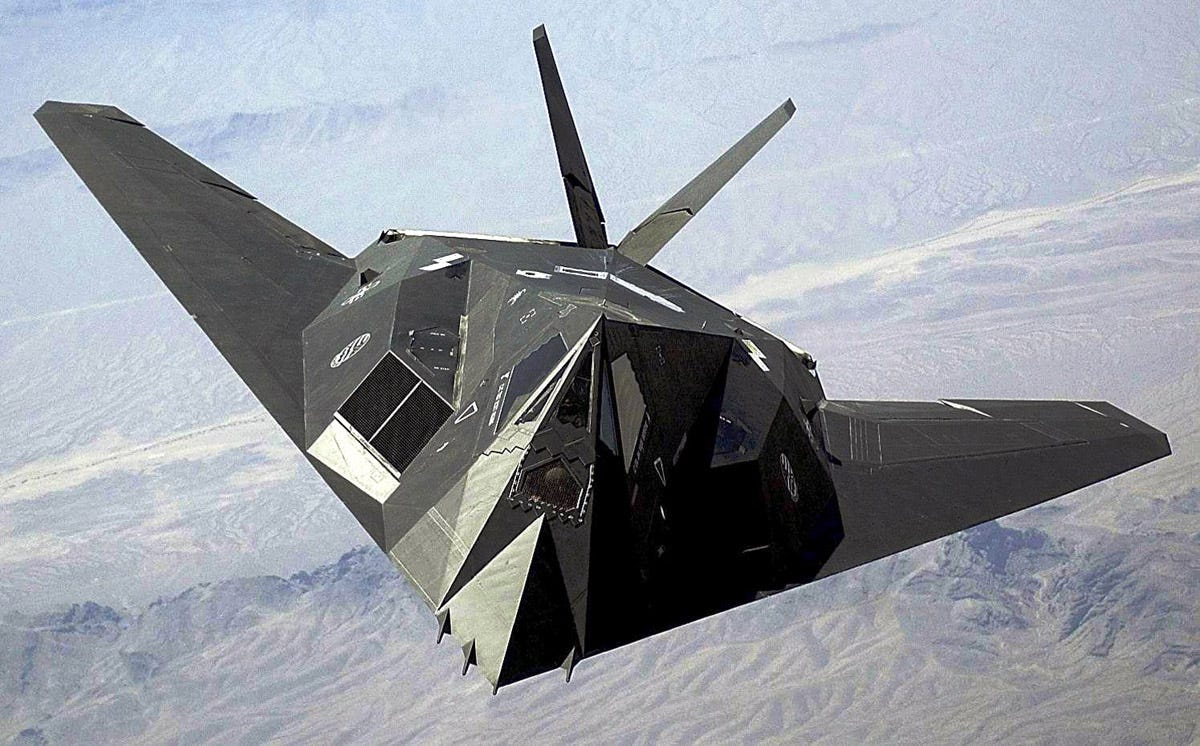Declassified: 18 little-known facts about US Air Force stealth program (pictures)
This is how the B-2 Stealth Bomber, F-22 Raptor and F-35 Lightning II avoid detection from enemy radar and infrared.

This is the first modern stealth fighter
Militaries have been pursing stealth aircraft technology since the advent of the airplane. But no one has mastered it quite like the US military.
This is the Lockheed F-117 Nighthawk. It's the first truly modern stealth aircraft...one that spent most of its life as a top-secret black project.
The creators called the design "hopeless"
The F-117 owes its unusual shape to the limits of 1970s computer technology; Lockheed had to make its sides flat and angular so its computer program could more easily minimize its radar cross section.
Lockheed scientists called its design the "hopeless diamond," diamond for its faceted shape and hopeless because of how difficult it is to stay airborne.

The shape makes it impossible to pilot manually
These planes are designed around their stealth feature, not performance or aerodynamics. The F-117's design, for example, is aerodynamically unstable across all three of its axes.
This means the plane is impossible to pilot manually. Its onboard computers must constantly calculate and make flight corrections to keep it from crashing.
The B-2 Bomber was designed to carry nukes
The F-117 was built to fight, but the iconic B-2 Stealth Bomber was built to nuke. It was designed to carry up to 16 2,400-pound nuclear bombs deep into guarded Soviet airspace...should the need have ever arisen.
By the time the B-2 underwent its first mission in 1999, though, the Cold War had long ended.
The B-2 is flat for a reason
The more vertical surfaces on a plane, the easier it is to spot on a radar screen. That's why the B-2 was designed as flat as possible, without a traditional tail.
This plane is covered in tiny iron balls
B-2 Stealth Bombers are covered in a substance known as iron ball paint. This coating of microscopic iron spheres resonates with incoming radar waves, absorbing their energy as heat.
The dark paint color, meanwhile, makes the B-2 difficult to spot during its late-night missions.
The B-2 is maintained in near-pristine condition
The paint job of the B-2 is so important to maintaining stealth that its surface is inspected for chips and scratches after every flight.
"Our pilots' lives depend on how well we do our job. There's no room for mistakes," said Staff Sgt. Jeff Schroeder.
It's one crazy-expensive aircraft
That level of attention to detail doesn't come cheap, though. Each B-2 Stealth Bomber costs the US roughly $2.13 billion. And that doesn't include the $135,000 it costs per-flight-hour to operate.
The stealthy secret? Triangles
The jagged tail end of the B-2 uses an important design feature called "re-entrant triangles." When radar hits it, the waves are reflected back onto the plane multiple times, lowering the waves' energy.
Even its exhaust is stealthy
The B-2 must also maintain a low heat signature to avoid detection by infrared.
To this end, the plane's internal fuel tanks act as heat sinks. The B-2 also mixes cool air into its exhaust, lowering its exit temperature.
This is the USAF's new $1.5 trillion stealth fighter
This is the F-35 Lightning II, the latest generation of stealth fighters. The US is expected to spend over $1.5 trillion(!) to design, purchase and operate 2,457 of these planes through their expected retirement date of 2070.
Even the cockpit is built with stealth in mind
The F-35 Lightning II may be largely invisible to radar, but its pilot's helmet isn't. Neither is its instrument panel.
To keep the interior invisible, the cockpit is covered in a thin film of vapor-deposited gold or indium tin dioxide to scatter radar waves away from the receiver.
This may be the most advanced helmet in the USAF
The F-35 utilizes a helmet-mounted display system that provides pilots with the data they need (for example, speed, altitude, targeting) projected on the helmet's visor.
The helmet also collects data from the plane's six infrared cameras, allowing the pilot to "see through" the plane and view the ground simply by looking between his legs, for example.
The F-35's weapons systems are well hidden inside the plane
Exterior mounted missiles are easy to detect on radar, so the F-35 has four hidden weapon bays instead: Two with air-to-air missiles, and two with air-to-surface missiles. It also carries a GAU-22/A cannon (25mm) in its gun pod.
The new F-35 is pretty terrible at flying
The F-35 Lightning II, years behind schedule and billions over budget, is riddled with problems.
Its software doesn't work right, the ejector seat has the potential to fail, the plane is incredibly difficult to maneuver and fuel inefficient, and its radar system is a mess. Oh, and its fuel tank is unusually susceptible to being struck by lightning.
This thing is as hard to spot as a marble
Not all stealth planes are clunky to fly, though. The F-22 Raptor can maintain supersonic flight, and is supermaneuverable.
And it's stealthy as hell. According to the USAF, its radar cross section is equivalent to that of a metal marble.
Only one stealth plane has ever been shot down
Stealth planes do have a major weakness: They briefly lose their stealthiness when they open their bomb doors. This fact was a key contributor to the only downing of an F-117 by the enemy, during the 1999 NATO bombing of Yugoslavia.
The pilot ejected from the plane unharmed.
The F-22 Raptor is our quarterback in the fight against ISIS
The F-22 Raptor flew its first mission in 2014, when it took out ISIS targets in Syria. It has been described as the "quarterback" plane of the USAF in the theater.

